Французкий реликварий с реликвией Истинного Креста, Страстей и Рождества Христова
A richly decorated silver reliquary monstrance surmounted by a cross and housing in the central glass-fronted cavity a precious relic of the True Cross of Jesus Christ (SS. Crucis D.N. = the Most Holy Cross of Our Lord) surrounded by five relics of the Christ's Life and Passion: of the Column of Flagellation (Ex Colum. Flag.), of the Thorn from the Crown of Thorns (SS. Coron. Spinae D.N.), of the Empty Tomb of Christ (Ex. Sepul. D.N.), of the Christ's Bandages (ex Fascia D.N.J.C.), and of the Nativity Grotto (Ex Praecepio D.N.). On the back, under a removable cap, the relics are secured by an undisturbed seal of red Spanish wax with an imprint of a coat of arms of Monsignor Jean-Augustin Germain (†), Cardinal Archbishop of Toulouse, France (1899–1928). The reliquary is hallmarked by a French Minerva sterling silver (950/1000) purity mark and a maker's mark of silversmith Favier in Lyon, a famous maker of French liturgical silver.
- ID# 76-RSSR-26
- Размер 14 inches (35 cm) tall
- Возраст около
- Происхождение около
- Материалы около
- Цена Цена по запросу
-

-

Реликварий с частицей от Власа Пресвятой Богородицы
Profusely decorated 19th-century Neapolitan glass-fronted gilt wood shadow-frame reliquary housing an older 18th century silver theca containing an extremely rare Hair relic of the Blessed Virgin Mary. The precious relic is affixed to a ground of red silk decorated with gilt paperolle and silver wire ornamentation and identified in Latin on a manuscript cedula label as Ex Capillis B.V.M. (Of the Hair of the Blessed Virgin Mary). On the back, the reliquary is secured by a wide horizontal silk cord held in place by two seals of red Spanish wax with an imprint of a coat of arms of Monsignor Giovanni Lercari (†1802), Archbishop of Genova (1767–1802).
- ID# 77-RSSR-18
- Размер Frame: 9 x 11 inches (22.5 x 27.5 cm)
- Возраст около
- Происхождение около
- Материалы около
- Цена Цена по запросу
-

Французкий реликварий с реликвией Святого Первомученика Стефана
A richly decorated gilt brass reliquary monstrance decorated by multicolored crystals and housing in the central glass-fronted cavity a first-class ex ossibus (of the bone) relic of Saint Stephen, the Protomartyr. A substantial relic comprised of multiple bone fragments is arranged in an X shape on the ground of red velvet surrounded by gilt paperolle with small pearls and identified in French on typeset cedula label as S. Etienne, 1-er M. (Saint Stephen, the First Martyr). On the back, under a removable cap, the relics are secured by an undisturbed seal of red Spanish wax with an imprint of a coat of arms of an unidentified Roman Catholic Archbishop.
- ID# 79-RSSR-125
- Размер 14 inches (35 cm) tall
- Возраст около
- Происхождение около
- Материалы около
- Цена Цена по запросу
-

Икона - Владимирская Богоматерь в окладе
Our Lady of Vladimir is one of the most highly venerated Orthodox icons and a typical example of Byzantine iconography. The original 12th-century icon survived and is displayed in the Tretyakov Gallery museum in Moscow. Even more than most famous icons, the original has been copied repeatedly for centuries and many copies now have considerable artistic and religious significance of their own. The icon is a version of the Eleusa (Tenderness) type, with the Christ child snuggling up to his mother's cheek. The venerated image was used to celebrate the coronations of tsars, the elections of patriarchs, and other important ceremonies of the Russian state. Her feast day is June 3.
- ID# 25-3285-023-068-SP3
- Размер 11 1/2 x 9 inches (29 x 23 cm)
- Возраст около
- Происхождение около
- Материалы около
- Цена ПРОДАНО!
-

-

Икона - Спас Ведержитель в окладе
Christ Pantocrator is one of the most common subjects in Russian iconography, and its iconography follows a traditional pattern. In these icons, Christ is depicted as a powerful and majestic figure, with his right hand raised in blessing and his left hand holding an open book of the Gospels. The term "Pantocrator" means "Almighty" or "Ruler of All," and the image of Christ in this role conveys his power and authority as the divine judge and ruler of the world. The icon portrays Christ with a stern expression, indicating his righteous judgment and the seriousness of his message. The icon's composition features Christ's head and shoulders in the center of the image, with his body slightly turned to the right. He is shown wearing a red tunic and blue mantle, with his long hair and beard flowing around his face. The Gospels are opened on Matthew 11:28 “Come unto me, all ye that labor and are heavy laden, and I will give you rest.”
Overall, the iconography of Christ Pantocrator is a powerful and striking representation of Christ's authority and judgment and a reminder of the spiritual power and majesty of the Christian faith.
- ID# 21-1433-012-131-SP3
- Размер 10 1/4 x 8 1/2 inches (26 x 22 cm)
- Возраст около
- Происхождение около
- Материалы около
- Цена $975
-

Икона - Казанская Богоматерь в окладе
Our Lady of Kazan is a holy icon of the highest stature within the Russian Orthodox Church and is considered a palladium of Russia for centuries until its theft and likely destruction in 1904. The icon represents the Virgin Mary as the protector and patroness of the city of Kazan. It is a close-up variant of the Hodegetria (Directress) style, it is noted mainly for the Child standing, with the Virgin chest length. The Kazan icons are traditionally small, following the original. The Kazan icon was very popular in Russia, especially as a wedding gift, and many copies were made in the design of the original. Two major Kazan Cathedrals, in Moscow and St. Petersburg, are consecrated to Our Lady of Kazan, as are numerous churches throughout the land. Her feast days are July 21 and November 4.
- ID# 22-10572-101-068-SP3
- Размер 10 1/4 x 8 1/2 inches (26 x 22 cm)
- Возраст около
- Происхождение около
- Материалы около
- Цена $775
-

Икона - Пресвятая Богородица Знамение
Our Lady of the Sign is one of the most beloved Russian miracle-working icons of Theotokos. The icon depicts Her during the Annunciation at the moment of saying, "May it be done to me according to your word." (Luke 1:38). The Virgin Mary is depicted frontally half-length, with her hands raised in a praying position, and the Child Jesus within a round aureole upon her breast representing him at the moment of his conception. The term Virgin of the Sign is a reference to the prophecy of Isaiah 7:14: "Therefore the Lord himself shall give you a sign; Behold, a virgin shall conceive, and bear a son, and shall call his name Immanuel."
- ID# 23-6520-055-051-SP3
- Размер 10 1/4 x 8 1/3 inches (26 x 21 cm)
- Возраст около
- Происхождение около
- Материалы около
- Цена $775
-

Икона - Богоматерь Всех скорбящих радости
Mother of God, Joy to All Who Sorrow of Moscow is the name of a famous wonderworking Russian Orthodox icon. The icon dates to a miracle that occurred on October 24, 1688, when a woman named Euphemia received healing from sickness after obeying a voice telling her to find this icon and have the priest celebrate a prayer with the blessing of water. The design of this icon depicts the Mother of God, depicted full-figured, standing with her Son in Heaven and God the Father above her in the clouds. Along both sides of the icon, framing the Mother of God, depicted are many suppliants asking for her intercession. The tenderness and kindness of a loving mother are evident in her face as She stands in paradise and yet among us.
- ID# 24-3915-027-156-SP3
- Размер 12 1/4 x 10 1/2 inches (31 x 27 cm)
- Возраст около
- Происхождение около
- Материалы около
- Цена $725
-

Не все артефакты, которые мы имеем в наличии, представлены на нашем сайте. Пожалуйста напишите нам, если вы ищете какой-то определенный предмет, но не видите его в нашем интернет – магазине.

Ознакомьтесь с гарантиями предоставляемыми клиентам нашим магазином.




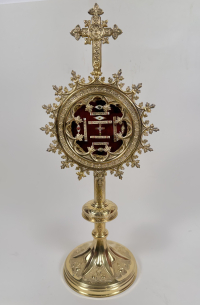
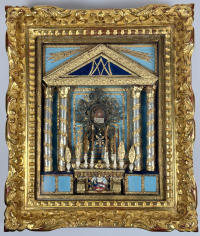
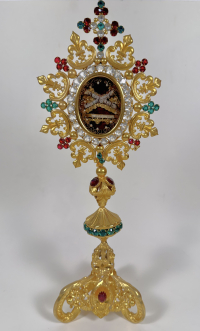
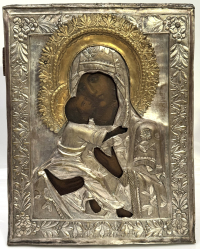
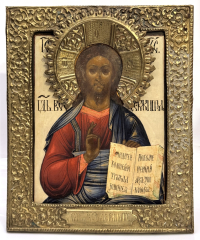
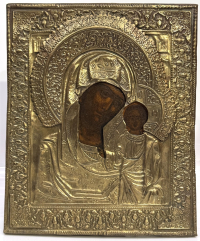
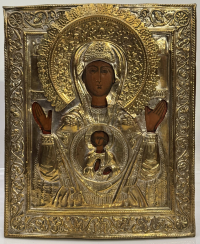
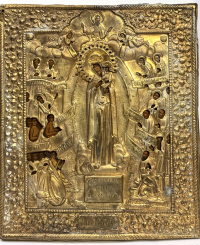

 Change language to English
Change language to English